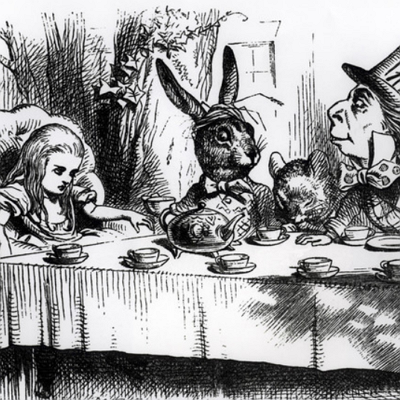 In the late 1980s I edited The Harmonic Astrology Newsletter, founded by David Hamblin. It had some distinguised contributors, including Mike Harding and Charles Harvey. But possibly the most interesting contributor was Terry Dwyer. He wrote a computer program, Starword, which created syntheses of people’s horoscopes. Terry was also a sceptic, and I think that he had serious doubts about whether astrology was worth bothering with. In one article he wrote, which I don’t have a copy of, he quoted from Shakespeare’s The Tempest:
In the late 1980s I edited The Harmonic Astrology Newsletter, founded by David Hamblin. It had some distinguised contributors, including Mike Harding and Charles Harvey. But possibly the most interesting contributor was Terry Dwyer. He wrote a computer program, Starword, which created syntheses of people’s horoscopes. Terry was also a sceptic, and I think that he had serious doubts about whether astrology was worth bothering with. In one article he wrote, which I don’t have a copy of, he quoted from Shakespeare’s The Tempest:
But this rough magic
I here abjure, and when I have required
Some heavenly music, which even now I do,
To work mine end upon their senses that
This airy charm is for, I’ll break my staff,
Bury it certain fathoms in the earth,
And deeper than did ever plummet sound
I’ll drown my book.
Maybe he only quoted the last two lines, I can’t remember. The lines were spoken by Prospero, who had decided to drown his book and break his staff – the symbols of the magic arts that he practiced. In Terry Dwyer’s case this was astrology. As far as I understand it, he gave it up because of the lack of scientific proof.
And in his article, Terry posed a question: What is the difference between an astronomer and an astrologer?
An astronomer is someone who looks into the skies and sometimes finds what they are looking for. The astrologer is someone who looks down at the horoscope and always finds what they are looking for. Which brings me to the subject of Chiron and the asteroids.
I remember when I first came across them. I had been studying astrology for about a year, and I came across Demetra George’s book The Asteroid Goddesses. At the back it has ephemerides for the four main asteroids, Ceres, Pallas, Juno and Vesta. And I think a few more. These asteroids, along with Chiron, discovered in 1977, were interesting novelties. I think you go through this phase, when you start studying a new subject. You go for things that are glittery and slightly unusual.
Talking about Chiron, I think there was a brief time in the 1980s when it almost took over from Jupiter. People suggested that it might even be the ruler of Sagittarius. It was the hot new thing in astrology, the wounded healer, the maverick, whatever. And the fact that it was probably a comet, only 124 miles across, seemed to be forgotten.
The problem with asteroids can be demonstrated with reference to any horoscope. For example, here is John F Kennedy’s chart, as it might have been seen before the discovery of Uranus in 1781:
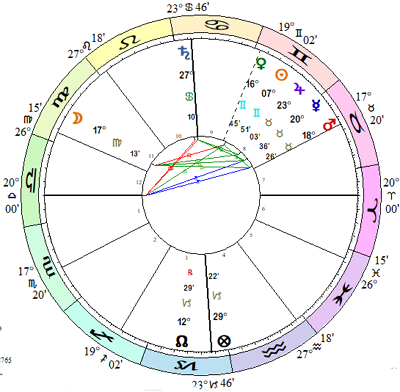
The horoscope is clean and simple. Saturn in Cancer is conjunct the Midheaven, indicating a position of leadership. Saturn might be in the sign of its detriment, but it is a daytime planet, in a day time chart, above the horizon. Also, at 27 10 Cancer, it is in its own terms. We also see JFK’s intellect and oratory: Mercury is in mutual reception with Venus in Gemini, and is conjunct Mars and Jupiter. In terms of JFK’s sex life, we have a packed Eighth House, and an exact Moon-Venus square. This square is wonderfully Jungian. The Madonna clashes with the Whore, Jackie clashes with Marilyn, who whoever else he slept with.
Essentially, we don’t need anything else to interpet the chart. However, I understand that some people like to use Uranus, Neptune and Pluto:
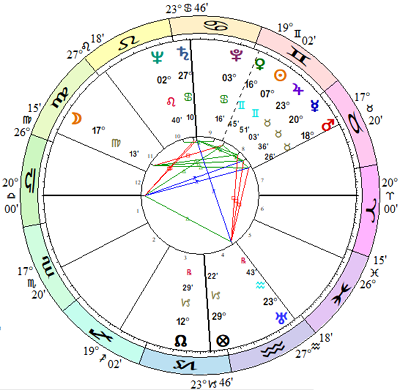
I am not sure if the addition of Uranus, Neptune and Pluto adds much. Although in my experience, Uranus is more of an influence than Neptune and Pluto, and its squares to Mercury, Mars and Jupiter added punch and vitality to JFK’s communication style. From an astronomical point of view, Uranus, unlike Neptune and Pluto, can sometimes be seen with the naked eye. This fact may be signficant, in terms of how much weight we give this planet in our interpretations.
Unfortunately, some people want to go further than the ten usual planets. They want to add the four main asteroids, Ceres, Juno, Pallas and Vesta. They also want to add Chiron, and for good measure, the point in space known as Lilith:
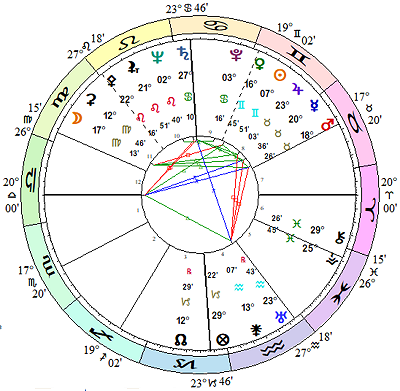
As you can see, the chart is starting to look cluttered. The Eighth House, such a vital part of who JFK was, is starting to lose it dominance. In other words, we’re getting distracted from the fundamental message of the chart. Yes, there is a conjunction between Pallas and Lilith, which is square Kennedy’s Mars. One might say that Mars square Lilith in a man’s chart represent the company of loose women. However, we can get this from Moon square Venus, especially as the Eighth House is so strong. So we don’t really need the extra points to tell us about JFK’s horoscope.
There is another problem. Terry Dwyer defined an astrologer as a person who looks down at a horoscope and always finds what they are looking for. Do you want to fall into this trap? If you add the asteroids and other points, you will always find what you are looking for. There will be little discernment in your readings, and your astrology will just become a meaning machine. You’ll find meaning in everything, and value in nothing.
And as one adds things to the chart, one is like a kindergartener playing with paints. It is fun to put a dash of green here, a dash of purple there… but eventually the colours merge into an amorphous brown mess. Rather like the chart below, after you have plastered it with a few dozen asteroids and extra points:
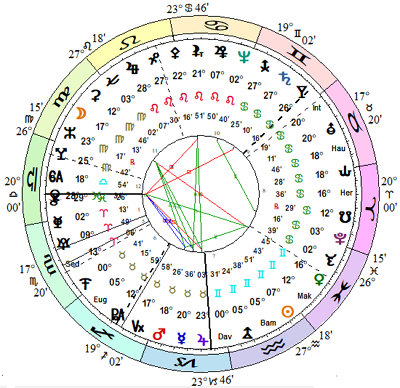
You also have to look at the issue statistically. Every time you add a new point to your chart, you are exponentially increasing the number of pairs to analyze. Here’s the graph:
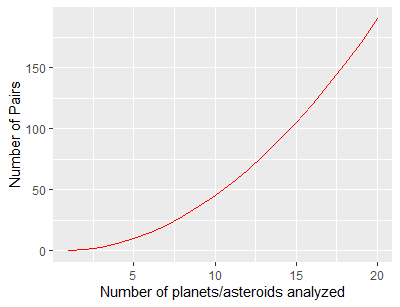
What this means is, that if you just use the seven traditional planets, you have the aspects between 21 pairs of planets to consider. If you throw in the Ascendant and the Midheaven, the number goes up to 36. Add Uranus, Neptune and Pluto and you’re on 66. Add the four major asteroids, Chiron and Lilith, and it is 153. In other words, you become over-saturated with possible combinations.
From the perspective of demonstrating that astrology works, this becomes a nightmare. In terms of aspects, one might have 153 ways of demonstrating an astrological effect. This creates the two problems of multiple comparison and cherry-picking. With so many combinations, you are inevitably going to find random connections between a series of charts. In the jargon, you’ll have an over-fitted solution, which will disappear when a test set is created, with multiple comparisons corrected for. Even Michel Gauquelin, whose astrology was very conservative, fell into the trap of making uncorrected multiple comparisons.
So what do you do, if you’re a puer aeternus, or a puella aeterna, and you refuse to grow out of using asteroids? What I suggest is that you take a leaf from statistics, and use a Bonferroni-style correction of your orbs. In other words adjusting aspect orbs, depending on how many points you are using.
Let us say your starting point is the ten planets, plus the Ascendant and the Midheaven. You are using an orb of 8 degrees for a conjunction or opposition, 5 degrees for a square or trine, 3 degrees for a sextile, and 1 degree 30 minutes for a semisquare, quincunx, semisquare or sesquiquadrate. These orbs are a matter of personal preference, and they are not writ in stone. However I would not suggest wider orbs, because otherwise you run into the usual problem of cluttering. And of course aspects work best when the orbs are tight.
Now, you decide to add Ceres, Juno, Pallas and Vesta. And Chiron and Lilith. You have increased the possible pairs from 66 to 153. This means you have to reduce your orb, using the fraction 66 divided by 153, which is .431. This will keep the number of possible aspects constant. Your new orbs will be:
Conjunction and Oppostion: 3 degrees 27 minutes
Square and trine: 2 degrees nine minutes
Sextile: 1 degree 18 minutes
Semisextile, quincunx, etc: 0 degrees 39 minutes.
If you plan on adding more points, you will have to reduce your orbs accordingly.
However, it would be much easier if you just stopped using the asteroids and other points. Or even better, restrict yourself to the traditional planets, from the Sun through to Saturn, with Uranus on special occasions.
Note: The formula for the number of pairs is k(k-1)/2, where k is the number of planets and points you are using.
:
Seriously studying astrology for more than fifty years. I like simplification, so I often do a preliminary examination using only the Seven. Not that I stop there. I couldn’t stop there because Pluto, for one, gives me hella pause. I will never ignore its prominence in a chart.
It’s taken longer for me to come to terms with Uranus, Neptune, and the two Nodes. Last came Ceres (Demeter) whom I associate with significations of the Sixth House. So Twelve in total–together with their angular relations when these are multiples of 30 degrees. But I don’t interpret the Signs, just the Houses. So that’s a simplification.
I like that others practice astrology differently; I enjoy visiting their methodologies. It’s interesting like taking a trip or sampling international cuisine. I must admit, however, that even though I can’t shake my personal fondness for the dwarf planet Ceres, it does give me heebie-jeebies to be confronted by a herd of asteroids–or even two/three asteroids. No accounting for astrological tastes.
In the present times can astrology be standardized? It would be like herding cats.
Thanks for the comment! I do use the signs, not least because I believe that essential dignity is important. Also, you need signs to allocate rulership. In terms of standardization, it is impossible. You also have to remember that astrologers have been arguing with each other for 1000 years or more, over much smaller points than we’re dealing with now. Herding cats, yes. Though bear in mind that I am a Gemini. I find differences more interesting than similarities.
My discovery is using pluto-135°, the most powerful point in the sky.
Yes, great article! New planet /asteroid discoveries are always exciting until they make everything hard work. Like a surprise toyat Christmas, which eventually lands in the glamourous good memories box in the attic. Yes, I also agree with keeping it simple, otherwise, as the saying goes – you can’t see the wood for the trees. Great explanation. Thankyou.
Thanks for visiting the site. Keeping it simple really is important, and you shouldn’t have to go beyond Saturn. Though as I suggested in the article, Uranus is on the fringes. It works a lot better than Neptune and Pluto, and has a certain consistency.
Archie, having studied astrology for more than 30 years now, would it surprise you to know that I still do not have any clear idea as to how Chiron manifests in the birth chart? Much of what I have read appears to be largely speculative, or merely parrots the usual wounded healer narrative. The only work that I have come across which seems worthwhile is “Midpoint Keys To Chiron” by Chris Brooks although this is by no means a definitive explanation of how Chiron operates.
I have an exact Jupiter-Chiron conunction in my chart, so it is very difficult to isolate its influence. I am not going to say it doesn’t work, but rather, it isn’t useful. I kind of associated Chiron with the generation that popularized it, in the 1980s. Everything was about psychology, and of course there had to be wounds. And you would have a couple of astrologers who would strongly associated themselves with Chiron, because they had spent a lot of time writing and lecturing about it.